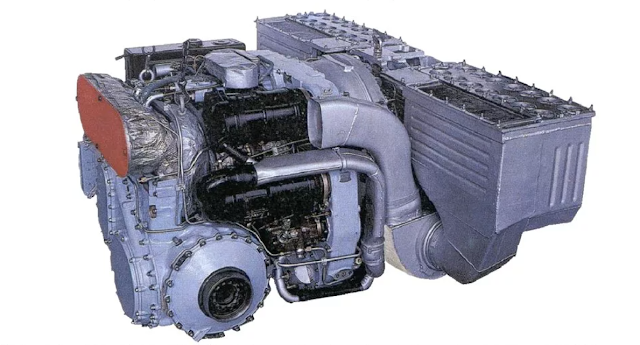Soviet MBTs utilize a parallelogram hinge mechanism which is used to link the vertical angular motion of the tank's main gun to the head mirror of the main sight. This is done by having 2 hinged parallelograms, one hinge as a common axis of rotation, which is brought into motion from an axis lever attached to a second hinge mounted through an eccentric bushing on the cannon's trunnions. The hinge for the common axis of rotation transfers vertical motion from the gun to the main sight while also duplicating the motion to the auxiliary sight.  |
| Basic parallelogram mechanism viewed from the right side |
 |
| Basic parallelogram mechanism viewed from the top |
 |
| Front view of parallelogram mechanism |
On the left is the lever arm that connects to the auxiliary sight, and behind the gunner's sight is the connector bridge, which connects the cannon's trunnion through the main parallelogram drive on the right. The main drive has 2 lever arms, which connect to the right side of the sight.
The left arm placement may vary due to some main sights utilizing an inbuilt bridge connector directly connecting to the auxiliary sight. This removes the need to duplicate the motion through a connector bridge.
 |
| 1G46 sight with 2 parallelogram linkage connectors. |
 |
| 1A40 mechanical parallelogram linkage |
Sights like 1A40(-1) have an internal linking bridge, which allows them to have a lever arm on the left side, allowing a direct connection to an auxiliary sight. For example, this would apply to the TPN-1-49-23.
 |
| 1A40-1 sight. On the left is the linking bridge for pairing an auxiliary night sight. |
Sights like 1G42 or 1G46 do not have such a feature, requiring sights like TPN-3, TPN-4 or PN-5 to get paired through a rear connector bridge mounted behind the main sight. This can be observed in the image with a hollow sight placement.
 |
| TPN-1-49-23 with a single link arm connector. |
 |
| TPN-3 with a single link arm connector. |
 |
| TPN-4 Buran-PA with single link arm connector |
Along with the older generation night vision devices, many of the late Soviet and early Russian thermal sights, like AGAVA-2 or Nocturne, use this parallelogram-linkage method to synchronize the mirror with the main sight.
 |
| AGAVA-2 sight. 1: rear connector bridge, 2: connector arm, 3: parallelogram connector |
 |
| Nocturne thermal imaging sight with a parallelogram mechanism |
The 1PN-96MT is an auxiliary thermal imaging sight, which uses the same parallelogram-linkage method to synchronize the internal mirror with the main sight mirror. 1PN-96MT has 2 parallelogram connectors requiring 2 lever arms. This allows the sight to not have its own inbuilt stabilization mechanism and instead rely on the main sight to stay on the correct LoS.
 |
| 1PN-96MT-01 paired with 1G46 sight |
 |
| 1PN-96MT with 2 connector points for parallelogram-linkage |
References: - Arms-Expo.ru - 1A40-1 tank sight
- Poisk.ru - 1G46
- Михаил Барятинский, Т-72 Уральская броня против НАТО - Mikhail Baryatinsky, T-72 Ural Armor against NATO
- Patent: RU2713717С1
- УСТРОЙСТВО ОРУЖИЯ
И ЕГО БОЕВОЕ ПРИМЕНЕНИЕ. Учебник в двух частях. Часть вторая. Омск, Издательство ОмГТУ, 2012
- С.А Беляков, ПРИБОРЫ НОЧНОГО ВИДЕНИЯ БРОНЕТАНКОВОЙ ТЕХНИКИ, Учебное пособие, Омск 2001
- ТАНК Т-72А
ТЕХНИЧЕСКОЕ ОПИСАНИЕ
И ИНСТРУКЦИЯ ПО ЭКСПЛУАТАЦИИ
КНИГА ПЕРВАЯ, МОСКВА
ВОЕННОЕ ИЗДАТЕЛЬСТВО
1986









.jpg)







Comments
Post a Comment